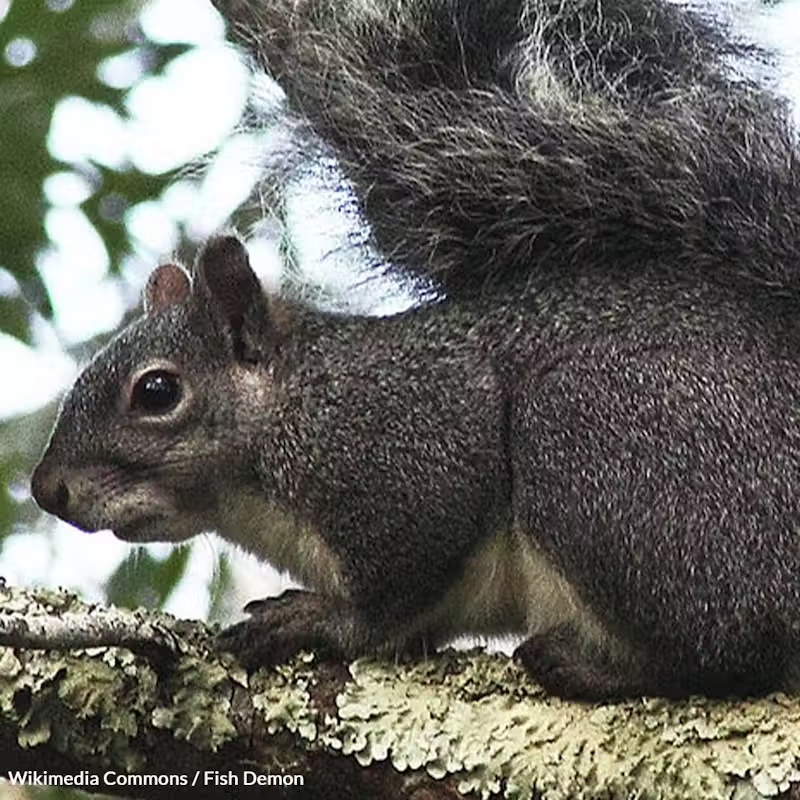Protect the Western Gray Squirrel
9,100 signatures toward our 30,000 Goal
Sponsor: The Animal Rescue Site
Support efforts to safeguard the Western gray squirrel and ensure the health and vitality of our natural world.

By signing this petition, you join us in urging the Washington Department of Fish and Wildlife (WDFW) to take decisive action to safeguard the Western gray squirrel and ensure the health and vitality of our natural world for generations to come.
In the heart of Washington state's stunning landscapes, a silent struggle unfolds. The Western gray squirrel1, once a symbol of thriving ecosystems, teeters on the brink of extinction. With its numbers dwindling and its habitat vanishing2, urgent action is required to safeguard this remarkable creature and the ecosystems it supports.
Why Does the Western Gray Squirrel Need Your Help?
Historically, Western gray squirrels adorned low- to mid-elevation forests with their distinctive gun-metal gray fur3. These magnificent tree squirrels reveled amidst the embrace of oaks, pines, and Douglas firs, enriching Washington's biodiversity. However, today, their existence is under grave threat.
Diminishing Habitat: Timber harvests, wildfires, land conversion, and climate change have forever altered their natural environment, pushing these squirrels to the brink1. Their once-thriving forests are rapidly vanishing, and the territory they navigate shrinks each day.
Critical Ecological Role: Beyond their aesthetic charm, Western gray squirrels play a pivotal role in their ecosystem4. Their unique foraging habits aid in the dispersion of truffle spores, which attach to tree roots, enabling trees to absorb crucial water and nutrients from the soil. This seemingly simple act has far-reaching ecological consequences that ripple throughout the forest.
Predation and Genetic Diversity: In the circle of life, these majestic creatures fall prey to other wildlife. Additionally, some populations face the grim reality of inbreeding, a situation that threatens genetic diversity and overall health5.
Act Now: Support the Reclassification of the Western Gray Squirrel!
Recognizing the severity of the situation, the Washington Department of Fish and Wildlife (WDFW) has taken a decisive stance. They propose reclassifying the Western gray squirrel from "threatened" to "endangered" status6. This critical change would usher in a suite of protective measures aimed at conserving the species, including stricter penalties for those who harm or kill them.
Reclassifying the Western gray squirrel is not just about protecting one species—it's about safeguarding the health and vitality of our entire ecosystem. Your support will:
- Deter Harm: Stricter penalties for harming or killing these squirrels will discourage activities that threaten their survival.
- Boost Conservation: More extensive conservation efforts will be implemented to protect their remaining habitats.
- Raise Awareness: By signing, you raise awareness about the importance of preserving our rich native wildlife.
This is a collective effort, and your signature matters. By working together, we can secure a future where thriving native ecosystems bear witness to our commitment to biodiversity and the preservation of all species, including the magnificent Western gray squirrel.
We urge you to take action now! Sign our petition in support of the WDFW's efforts to reclassify the Western gray squirrel from "threatened" to "endangered" status. Your signature is a powerful statement that you stand with us in preserving this iconic species and the diverse ecosystems it sustains!
- Washington Department of Fish & Wildlife (2023), "Western gray squirrel (Sciurus griseus)."
- Loreen A. Ryan and Andrew B. Carey, United States Department of Agriculture, Forest Service (May 1995), "Biology and Management of the Western Gray Squirrel and Oregon White Oak Woodlands: With Emphasis on the Puget Trough."
- Animalia (2023), "Western Gray Squirrel."
- George Wooten, Pacific Biodiversity Institute (14 February 2013), "Western gray squirrel (Sciurus griseus) background information."
- Naturalist, "Western Gray Squirrel."
- State of Washington (November 2007), "Western Gray Squirrel Recovery Plan."
The Petition:
To the Washington Department of Fish and Wildlife (WDFW),
We, the undersigned, wholeheartedly support the efforts of the Washington Department of Fish and Wildlife (WDFW) to reclassify the Western gray squirrel from "threatened" to "endangered" status. We believe that urgent action is needed to protect this iconic species and the invaluable role it plays in our ecosystem.
Why the Western Gray Squirrel Needs Protection:
- Diminishing Habitat: The Western gray squirrel's habitat is rapidly disappearing due to factors like timber harvests, wildfires, land conversion, and climate change.
- Declining Numbers: Their population has significantly declined, and without intervention, they face the risk of becoming extinct in Washington.
- Unique Ecological Role: Western gray squirrels are vital for their role in spreading truffle spores that help trees absorb water and nutrients, contributing to the overall health of our forests.
- Predation and Genetic Diversity: These squirrels are prey to other wildlife, and some populations are already suffering from inbreeding, threatening genetic diversity.
How These Actions Will Ensure Thriving Native Ecosystems in the Future:
By reclassifying the Western gray squirrel as "endangered," we can:
- Implement stricter penalties for harming or killing them, discouraging activities that threaten their survival.
- Increase conservation efforts to protect their remaining habitats.
- Raise awareness about the importance of preserving our diverse native wildlife.
Together, we can secure a future where thriving native ecosystems are a testament to our commitment to biodiversity and the preservation of all species, including the remarkable Western gray squirrel.
Sincerely,
 Welcome Back! Log In to Continue
Welcome Back! Log In to Continue